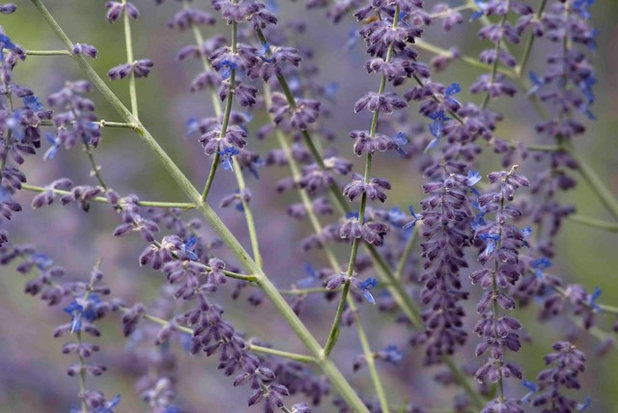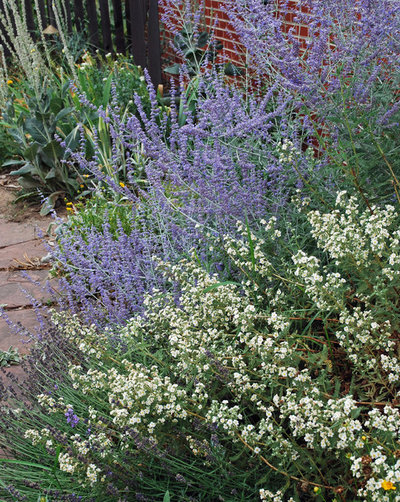In late fall through winter, Russian sage sheds its flowers to reveal stately silvery stems for a perfect snowscape complement. But it's also safe to say that purple-flowering plants reign in spring and summer gardens, and Russian sage, a particularly popular spiky specimen, stands above similarly hued sorts with a soft, purple haze of blooms — making this plant a wonderful garden accessory year-round.

The New York Botanical Garden
Botanical name: Perovskia atriplicifolia (hybrids and cultivars)
Common name: Russian sage
USDA zones: 5 to 9 (find your zone)
Water requirement: Little to moderate
Light requirement: Full sun
Mature size: 3 to 4 feet tall and wide
Benefits and tolerances: Drought tolerant; deer resistant; attracts butterflies and hummingbirds; grows at higher altitudes
Seasonal interest: Flowers summer into fall; architectural
When to plant: Spring to summer

Jay Sifford Garden Design
Distinguishing traits. Russian sage is most notably lauded for its flowers and ability to thrive where little else can grow. Small purple flowers bloom from summer into fall, drawing butterflies and hummingbirds into the garden. Leaves are soft and grayish-green, and emit a subtle, sage-like aroma.
Russian sage's garden interest persists well past its blooms have faded. Attractive seed heads remain on the stems past the first frost, creating visual delight in stark winter gardens. The unique upright structure of the plant survives into winter, drawing interest with its skeletal shape and silvery stems.

Russian sage projects high above surrounding plants in this Slovenian garden.

Arrow. Land + Structures
How to use it. Mass Russian sage or use it along a garden path. Its height and fine texture reach above surrounding foliage in a distinct and attractive way. In a mass, Russian sage can even be used as a seasonal screen.
Plant it alongside lavenders or salvias for subtle contrast in color and texture, or opt for a naturalistic mixed perennial planting. Russian sage is a butterfly attractor; cluster other butterfly attractors for a bigger garden show.
Russian sage thrives where many other plants fail; but a blessing can also be a burden, as the vigorous growth of the plant can overpower surrounding plantings. Plant it alongside grasses or other dominant plants that can keep Russian sage in check without your constant management.

Jocelyn H. Chilvers
Planting notes. Russian sage grows well — almost too well in some regions. Be sure that it is not considered invasive in your area. If it's safe to proceed, find a garden spot that will receive ample sunlight — at least several hours a day, as Russian sage prefers sunny, warm summers. It's often used in xeriscape gardens but is tolerant of light supplemental watering. Limiting watering may prevent Russian sage from spreading too vigorously.
There's a common complaint that Russian sage has the tendency to flop over. Dry, well-drained soil light in nitrogen may help avoid this. If you notice that your Russian sage is leaning a little wearily, cut it back by half in early summer or when the plants are about 1 foot tall. This will help produce fuller, more robust growth to keep your plants standing tall.

The New York Botanical Garden
Popular cultivars, like 'Blue Spire' (shown) are smaller, very common and may be less likely to flop over.
Have you grown Russian sage? We'd love to see it in your summer and winter gardens. Share a photo in the Comments below.





